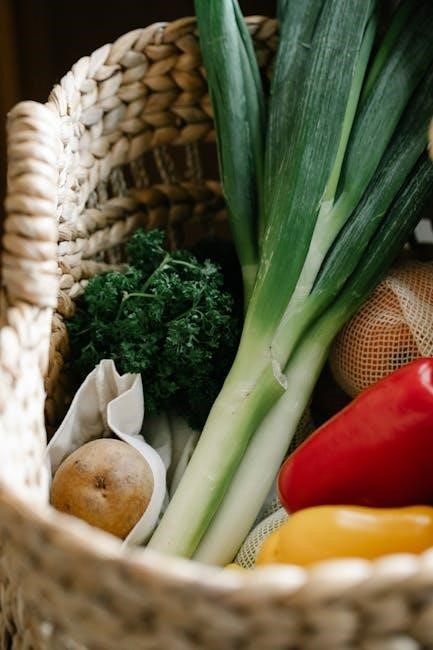whole 30 meal plan week 1 pdf
The Whole30 meal plan is a structured approach to resetting your eating habits with whole, unprocessed foods. It improves energy, supports health, and kickstarts a healthier lifestyle.
Overview of the Whole30 Program
The Whole30 program is a 30-day dietary reset focused on eliminating grains, dairy, legumes, added sugars, and processed foods. It aims to improve energy, digestion, and overall health by emphasizing whole, unprocessed foods like meats, vegetables, fruits, and healthy fats. The program encourages meal planning and preparation to avoid cravings and stay on track. It also provides a supportive community and resources, such as downloadable meal plans and grocery lists, to help participants succeed during their journey.
Importance of Meal Planning for Success
Effective meal planning is essential for thriving on the Whole30 program. It helps avoid unhealthy choices, reduces stress, and ensures compliance with program rules. By organizing meals in advance, participants can avoid cravings, stay on track, and maintain energy levels. A structured plan also saves time and fosters accountability, making it easier to stick to the program. Downloadable meal plans and grocery lists simplify the process, ensuring a smooth transition into the Whole30 lifestyle and setting the foundation for long-term success.

Key Components of a Week 1 Meal Plan
A well-structured plan includes balanced meals, snacks, and whole foods. Utilizing downloadable PDFs and grocery lists ensures compliance and simplifies the process for a successful start.
Grocery List Essentials
A well-prepared grocery list is crucial for Week 1 of the Whole30 program. Focus on whole, unprocessed foods like grass-fed meats, wild-caught fish, fresh vegetables, and healthy fats. Include items like eggs, avocado, and nuts for quick meals. Stock up on pantry staples such as coconut oil, olive oil, and spices for flavor. Avoid sugars, grains, and processed foods. Organizing your list by categories (e.g., proteins, veggies, fats) helps streamline shopping and ensures compliance with Whole30 rules. A downloadable PDF list can simplify the process.
Prep Tips for Week 1
Preparation is key to succeeding in Week 1 of Whole30. Start by planning meals, making a grocery list, and prepping ingredients like chopping veggies or cooking proteins. Cook bulk recipes like casseroles or stews for easy leftovers. Portion meals to save time during the week. Keep snacks ready, such as hard-boiled eggs or sliced veggies, to avoid temptation. Use a meal template to guide portion sizes and timing. Schedule prep days to ensure you stay organized and compliant with the program. This structure helps reduce stress and keeps you on track.

Daily Meal Plans for Week 1
Daily meal plans provide a clear structure, with breakfast, lunch, dinner, and snacks, ensuring you stay nourished and focused throughout the first week of Whole30.
Day 1: Breakfast, Lunch, Dinner, and Snack Ideas
Start your journey with a Paleo Breakfast Casserole, packed with eggs, veggies, and spices. For lunch, enjoy Taco Burgers with a fresh salad and zesty chili-lime dressing. Dinner features Slow Cooker Tuscan Chicken Stew, rich in flavors and nutrients. Snack on fresh veggies with guacamole or almond butter for a satisfying crunch. These meals are designed to keep you full, energized, andcommitted to your Whole30 goals.
Day 2: Balanced and Delicious Recipes
Begin Day 2 with a hearty Chicken Salad Lettuce Wrap, featuring grilled chicken, fresh veggies, and a zesty dressing. For lunch, try Baked Salmon with a side of roasted sweet potatoes and steamed broccoli. Dinner includes Spaghetti Squash with Meat Sauce, a flavorful and comforting option. Snack on fresh berries or sliced cucumbers with a sprinkle of sea salt for a light, refreshing treat. These meals are designed to keep your taste buds engaged while staying Whole30 compliant.
Day 3: Simple and Nutritious Options
Start Day 3 with Scrambled Eggs with Spinach and Mushrooms, a quick and protein-packed breakfast. For lunch, enjoy Turkey Lettuce Wraps with avocado and tomato slices. Dinner features Grilled Shrimp Skewers alongside roasted zucchini and sweet potato wedges. Keep snacks simple with Cucumber Slices and Almonds. These meals are easy to prepare, nutrient-dense, and designed to fuel your body while keeping you on track with your Whole30 journey.
Day 4: Energizing Meals to Combat Fatigue
Combat fatigue with Bacon and Egg Sweet Potato Hash for breakfast, packed with protein and healthy fats. Lunch features Grilled Chicken Salad with mixed greens, cucumber, and a zesty olive oil dressing. Dinner includes Beef Stir-Fry with broccoli, bell peppers, and cauliflower rice. Snack on Apple Slices with Almond Butter for a quick energy boost. These meals are designed to replenish energy levels and keep you motivated during your Whole30 journey.
Day 5: Flavorful and Satisfying Dishes
Start Day 5 with a Spicy Breakfast Skillet, featuring ground beef, bell peppers, onions, and eggs. For lunch, enjoy a Cobb Salad with grilled chicken, avocado, and a homemade vinaigrette. Dinner brings Baked Salmon with roasted asparagus and cauliflower mash. A midday snack of Cucumber Slices with Fresh Dill keeps you refreshed. These meals are crafted to deliver bold flavors while maintaining Whole30 compliance, ensuring you stay satisfied and motivated throughout the day.
Day 6: Creative Meal Ideas to Stay on Track
Day 6 brings fresh inspiration with a Grilled Shrimp and Veggie Skillet for breakfast, packed with zucchini, cherry tomatoes, and garlic. Lunch features Stuffed Bell Peppers with ground turkey, cauliflower rice, and spices. For dinner, enjoy a Beef and Broccoli Stir-Fry with sesame oil and a hint of ginger. A snack of Sliced Apples with Almond Butter keeps energy levels steady. These meals are designed to keep your taste buds engaged while staying compliant, ensuring you remain motivated and satisfied.
Day 7: Final Push for a Strong Finish
Celebrate the end of Week 1 with a Spinach and Mushroom Breakfast Skillet, featuring scrambled eggs and avocado. For lunch, a Grilled Chicken Caesar Salad with romaine lettuce and homemade dressing keeps things fresh. Dinner brings Baked Salmon with Asparagus and Sweet Potatoes, a flavorful and nutritious option. End the week with a satisfying Fresh Fruit Salad as a light snack. These meals are designed to fuel your body and leave you feeling accomplished and ready to tackle Week 2 with confidence.

Tips for Success in Week 1
Plan meals, prep ahead, and stay hydrated. Listen to your body, and don’t skip meals. Manage cravings with healthy snacks and focus on whole, nutrient-dense foods.
Managing Cravings and Hunger
Cravings and hunger are common in Week 1 of Whole30. Stay hydrated, eat protein and healthy fats with each meal, and keep snacks like veggies and nuts on hand. Plan ahead to avoid temptation, and focus on nutrient-dense foods to keep you full. Remember, cravings are temporary, and staying committed will help you push through. Avoid unhealthy alternatives and remind yourself why you started—it’s worth the effort for long-term benefits.
Staying Hydrated and Energetic
Staying hydrated is crucial during Week 1 of Whole30 to combat fatigue and support energy levels. Drink plenty of water throughout the day and consider incorporating electrolyte-rich foods like avocados and bananas. Balanced meals with protein, healthy fats, and vegetables help maintain energy. Avoid sugary drinks and focus on whole, nutrient-dense foods to keep your body fueled. Listening to your hydration needs and staying organized with meals will help you feel more energetic and focused as you progress through the program.

Common Challenges and Solutions
Common challenges include cravings, fatigue, and social pressures. Solutions involve meal prep, staying hydrated, and relying on Whole30-compliant recipes to maintain motivation and energy levels.
Navigating Food Cravings
Food cravings during the first week of Whole30 can be intense due to sugar and carb withdrawals. Stay hydrated and keep compliant snacks like veggies, nuts, and fruits handy. Meal prep is key—having healthy options ready reduces temptation. Avoid exposure to non-compliant foods and focus on nutrient-dense meals to stabilize blood sugar. Use the grocery list to ensure you’re stocked with Whole30-friendly ingredients. Remember, cravings are temporary, and staying committed will help you overcome them and achieve your health goals.
Handling Social and Emotional Triggers
Social and emotional triggers can derail your Whole30 progress, especially in the first week. Communicate your goals to friends and family to gain their support. Avoid situations involving non-compliant foods, and always have a backup plan, like bringing your own snacks. Emotional eating is common, so identify your triggers and replace them with healthy habits, such as drinking water or going for a walk. Stay accountable by sharing your struggles with a Whole30 community or partner. Remember, the program is about more than food—it’s about building self-awareness and resilience.
Completing Week 1 of Whole30 is a significant milestone. Reflect on your progress, celebrate small victories, and stay committed. Use the momentum to plan and prepare for Week 2, ensuring continued success on your journey toward healthier habits and a stronger relationship with food.
Reflecting on Week 1 Progress
By the end of Week 1, you’ve likely noticed significant changes in your energy levels, digestion, and overall well-being. Take time to reflect on your journey, tracking improvements and challenges. Celebrate victories, like mastering new recipes or reducing cravings. Identify areas for adjustment, such as portion sizes or meal timing. Acknowledge the initial struggles, like headaches or fatigue, but recognize how your body is beginning to heal. This reflection helps you stay motivated and prepared for the weeks ahead, ensuring continued success on your Whole30 journey.
Preparing for Week 2 and Beyond
As you complete Week 1, focus on maintaining momentum by introducing new recipes and rotating protein sources to keep meals exciting. Use leftovers creatively to minimize waste and save time. Review your Week 1 progress to identify what worked well and what didn’t, adjusting portion sizes or meal timing as needed. Download additional resources like the Whole30 PDF guides for inspiration and planning. Stay committed to the program’s principles, and remember, the benefits—like increased energy and improved digestion—will only grow stronger in the coming weeks.
